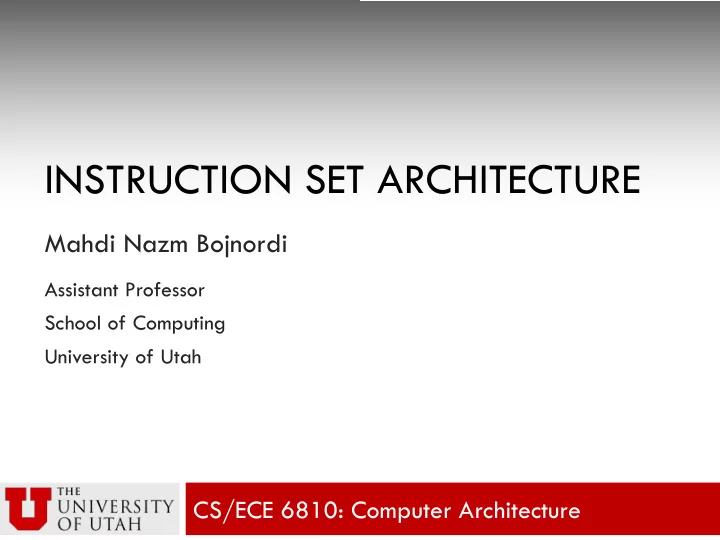

INSTRUCTION SET ARCHITECTURE Mahdi Nazm Bojnordi Assistant Professor School of Computing University of Utah CS/ECE 6810: Computer Architecture
Overview ¨ Announcement ¤ Sept. 5 th : Homework 1 release (due on Sept. 12 th ) ¨ This lecture ¤ Instruction set architecture (ISA) ¤ RISC vs. CISC ¤ Memory addressing ¤ Instruction format
What is ISA? ¨ Instruction Set Architecture ¤ Well-defined interfacing contract between hardware and software ¤ Does define n The functional operations of units n How to use each functional unit ¤ Does not define n How functional units are implemented n Execution time of operations n Energy consumption of operations
Example Problem ¨ Which one may be guaranteed by an ISA? ¤ The number of instructions supported by processor ¤ The number of multipliers used by processor ¤ The width of operands ¤ Sequence of instructions that results in an error ¤ Sequence of instructions that results in lower energy consumption ¤ The total number of instructions for an application program ¤ The total amount of main memory (e.g., DRAM)
Example Problem ¨ Which one may be guaranteed by an ISA? ¤ The number of instructions supported by processor YES ¤ The number of multipliers used by processor NO ¤ The width of operands YES ¤ Sequence of instructions that results in an error YES ¤ Sequence of instructions that results in lower energy NO consumption ¤ The total number of instructions for an application NO program ¤ The total amount of main memory (e.g., DRAM) NO
ISA to Programmer Interface ¨ Internal machine states ¤ Architectural registers, control registers, program counter ¤ Memory and page table ¨ Operations ¤ Integer and floating-point operations ¤ Control flow and interrupts ¨ Addressing modes ¤ Immediate, register-based, and memory-based
ISA Types ¨ Operand locations
Which Set of Instructions? ¨ ISA influences the execution time ¤ CPU time = IC x CPI x CT ¨ Complex Instruction Set Computing (CISC) ¨ Reduced Instruction Set Computing (RISC)
Which Set of Instructions? ¨ ISA influences the execution time ¤ CPU time = IC x CPI x CT ¨ Complex Instruction Set Computing (CISC) ¤ May reduce IC, increase CPI, and increase CT ¤ CPU time may be increased ¨ Reduced Instruction Set Computing (RISC) ¤ May increases IC, reduce CPI, and reduce CT ¤ CPU time may be decreased
RISC vs. SISC RISC ISA CISC ISA ¨ Simple operations ¨ Complex operations ¤ Simple and fast FU ¤ Costly memory access ¨ Fixed length ¨ Variable length ¤ Simple decoder ¤ Complex decoder ¨ Limited inst. formats ¨ Limited registers ¤ Easy code generation ¤ Hard code generation
Memory Addressing ¨ Register ¤ Add r4, r3 ¨ Immediate Add ¤ Add r4, #3 Reg ¨ Displacement ¤ Add r4,100(r1) Mem ¨ Register indirect ¤ Add r4, (r1)
Memory Addressing ¨ Register ¤ Add r4, r3 Reg[4]=Reg[4]+Reg[3] ¨ Immediate Add ¤ Add r4, #3 Reg[4]=Reg[4]+3 Reg ¨ Displacement ¤ Add r4,100(r1) …+Mem[100+Reg[1]] Mem ¨ Register indirect ¤ Add r4, (r1) …+Mem[Reg[1]]
Memory Addressing ¨ Indexed ¤ Add r3, (r1+r2) ¨ Direct Add ¤ Add r1, (1001) Reg ¨ Memory indirect ¤ Add r1,@(r3) Mem ¨ Auto-increment ¤ Add r1, (r2)+
Memory Addressing ¨ Indexed ¤ Add r3, (r1+r2)…+Mem[Reg[1]+Reg[2]] ¨ Direct Add ¤ Add r1, (1001) …+Mem[1001] Reg ¨ Memory indirect ¤ Add r1,@(r3) …+Mem[Mem[Reg[3]]] Mem ¨ Auto-increment ¤ Add r1, (r2)+ …+Mem[Reg[2]] Reg[2]=Reg[2]+d ¤
Memory Addressing ¨ Auto-decrement ¤ Add r1, -(r2) Add ¨ Scaled Reg ¤ Add r1, 100(r2)[r3] Mem
Memory Addressing ¨ Auto-decrement ¤ Add r1, -(r2) Reg[2]=Reg[2]-d …+Mem[Reg[2]] ¤ Add ¨ Scaled Reg ¤ Add r1, 100(r2)[r3] …+Mem[100+Reg[2]+Reg[3] x d] ¤ Mem
Example Problem ¨ Find the effective memory address ¤ Add r2, 200(r1) Registers ¤ Add r2, (r1) r1 100 r2 200 ¤ Add r2, @(r1) Memory … … 100 400 200 500 300 600 400 700 500 800
Example Problem ¨ Find the effective memory address ¤ Add r2, 200(r1) n r2 = r2 + Mem[300] Registers ¤ Add r2, (r1) r1 100 n r2 = r2 + Mem[100] r2 200 ¤ Add r2, @(r1) Memory n r2 = r2 + Mem[400] … … 100 400 200 500 300 600 400 700 500 800
Instruction Format ¨ A guideline for generating/interpreting instructions ¨ Example: MIPS ¤ Fixed size 32-bit instructions ¤ Three opcode types n I-type: load, store, conditional branch Opcode RS RT Immediate n R-type: ALU operations Opcode RS RT RD ShAmnt Funct n J-type: jump Opcode
Recommend
More recommend